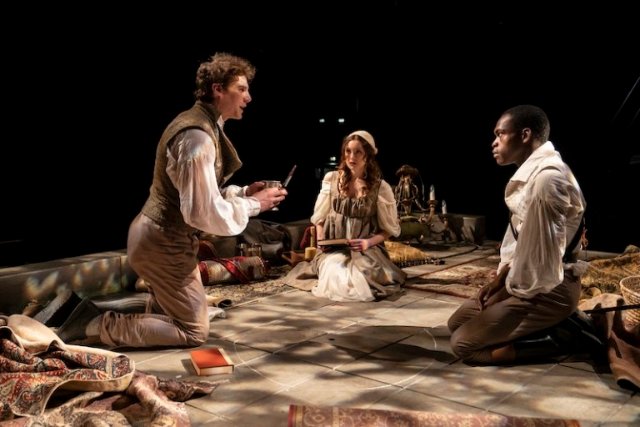Mary Shelley’s Frankenstein
From Chicago’s Lookingglass to Princeton’s McCarter
By: Nancy Bishop - Jun 06, 2019
Last year was the 200th anniversary of the publication of Mary Shelley’s landmark horror novel, Frankenstein; or, The Modern Prometheus, which explains why we have been able to see four different versions of the Frankenstein story on stage in
The final production of this series is Lookingglass Theatre’s Mary Shelley’s Frankenstein, written and directed by David Catlin, which wraps the story of Mary Shelley the writer around her story of the doctor and his creature. With assistance from the Actors Gymnasium, the Lookingglass crew creates a dazzling staging of the story.
It begins with five young people sitting around a fire, drinking wine, during a rainy evening at a villa on
As Mary’s ghost story comes to life, Dr. Frankenstein (Briggs) leaves his home to study this science; he’s obsessed with the idea of reanimating lifeless material and succeeds years later when his creature (Gallagher) comes to life. The lonely mute creature roams the countryside and finds that, although he wishes to befriend others and learn their language and their ways, his appearance makes that impossible. He demands that the doctor create a mate for him, promising they will travel far away and never return. Meanwhile, the doctor has returned from his studies to reunite with his dear friend and fiancée Elizabeth (Dewdney). Unfortunately, the creature has learned where the doctor lives and tracks him there.
The stunning Lookingglass production uses projections, ropes and pulleys, a plastic-sheeted chamber, floor-traps, and the stairways, ladders and catwalks of the waterworks theater space. (At intermission, it’s fascinating to watch the crew and actors prep the stage for act two.) Daniel Ostling’s scenic design combined with Catlin’s direction takes full advantage of the athleticism and physical training of the Lookingglass ensemble, coached here by circus designer Sylvia Hernandez-DiStasi. The rigging is designed by Rigability Inc. Lighting design is by William C. Kirkham and sound design and composition by Rick Sims. Sully Ratke’s costuming is ingenious and flexible, taking characters from ocean voyages to luxury villas to the arctic and back.
The cast of five is superb in its demanding double- and triple-role casting. Dewdney is fresh and almost ethereal in her roles as Mary and Elizabeth. Gonzalez-Cadel (notable for her award-winning performance in Lela and Co. at Steep Theatre) excels at every turn, as do Briggs, Gallagher and Balogun.
Popular culture has many variations on the Frankenstein story. Of the dozens of film versions, two are particularly famous—James Whale’s 1931 version starring Boris Karloff as the monster, and Mel Brooks’ 1974 comedy/horror film, Young Frankenstein, starring Gene Wilder as a descendant of the doctor and Peter Boyle as the monster. Both are enmeshed in pop culture beliefs about the nature of the “Frankenstein monster” and focus on the horror aspect of the story. This year’s theatrical productions rise far above pop culture to tell the sad and romantic story of Mary Shelley’s own life and her masterwork.
Mary Shelley’s Frankenstein continues through August 4 at Lookingglass Theatre,
Following the
Courtesy of Third Coast Review.

